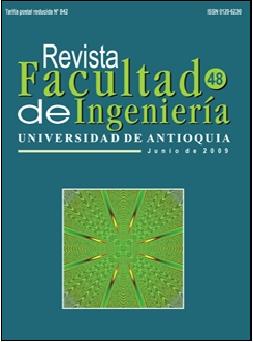Study and characterization of bricks from a historical bridge in Buga (Valle del Cauca)
DOI:
https://doi.org/10.17533/udea.redin.16446Keywords:
Bridges of brick arch, historical materials, ceramic piecesAbstract
In Colombia, bricklaying is constituted as a very significant construction technique present in historical buildings. However, with changes in their use, which generally implied increased dynamic loads, strong environmental variations, increased pollution, and the presence of different living organisms – among other factors – in recent years have apparently accelerated the deterioration of the materials conforming them (brick and lime mortar), in many occasions making it necessary to determine their physical and mechanical properties along with their chemical and mineralogical composition to diagnose the real state of the structure. This article explores the appropriate routines for such characterization to permit their future application in restoration processes of historical buildings. From the case study involving the masonry brick arch bridge constructed in the city of Buga (Valle del Cauca) during the second half of the 19th century, we will establish how mechanical analysis of the bricks allows having reference patterns of its resistance behavior; simultaneously, mineralogical characterization permits identifying the composition and firing temperature of the bricks originally used in the construction.
Downloads
References
J. A. Galindo, J. A. Paredes. Puentes de arcos de ladrillo en la región del Alto cauca. Una tradición constructiva olvidada. Bogotá. Universidad Nacional de Colombia. 2008. pp. 252-267.
J. Warren. Conservation of Bricks. Ed. Butterworths/ Heinemann. Oxford. 1999. pp. 132-146.
P. Cardiano, S. Ioppolo, C. Stefano, A. Pettignano, S. Sergi, P. Piraino. “Study and chatacterization of the ancient bricks of monastery of “San Filippo di Fragalà Razzanò (Sicily)”. Analytica Chimica Acta. Vol. 519. 2004. pp. 103-111. DOI: https://doi.org/10.1016/j.aca.2004.05.042
P. Duminuco, M. P. Riccardi, B. Messiga, M. Setti. “Modificazioni tessiturali e mineralogiche come indicatori della dinamica del proceso di cottura di manufatti ceramic”. Ceramurgia. Vol. XXVI. 1996. pp. 281-288.
P. Duminuco, B. Messiga, M. P. Riccardi. “Firing process of natural clays. Some microtextures and related phase compositions”. Thermochimica Acta. Vol. 321. 1998. pp. 185-190. DOI: https://doi.org/10.1016/S0040-6031(98)00458-4
J. Capel, F. Huertas, J. Linares. “High temperature reactions and use of Bronze Age pottery from La Mancha central Spain”. Miner. Petrogr. Acta. Vol. 29- A. 1985. pp. 563-575.
S. Shoval. “The firing temperature of a Persian-period pottery kiln at Tel-Michal, Israel, estimated from the composition if its pottery”. J. Thermal Anal. Vol. 42. DOI: https://doi.org/10.1007/BF02546999
pp. 175-185.
Instituto Colombiano de Normas Técnicas y Certificación. NTC 674: Método de ensayo para determinar porosidad aparente, absorción de agua, gravedad específica aparente y densidad aparente por agua en ebullición de ladrillos refractarios y piezas refractarias quemadas. Bogotá. Icontec. 2002. pp. 5-28.
Instituto Colombiano de Normas Técnicas y Certificación. NTC 682: Método de ensayo para determinar la resistencia a la compresión en frío y el módulo de ruptura de refractarios. Bogotá. Icontec. 2000. pp. 7-31.
A. E. Charola, L. Lazarini. “Deterioration of brick masonry caused by acid rain”. Am. Chem. Soc. Vol. 25. 1986. pp. 250-258. DOI: https://doi.org/10.1021/bk-1986-0318.ch017
D. N. Winslow, C. L. Kilgour, R. W. Crooks. “Predicting the durability of bricks”. Am. Cera. Soc. for Testing Materials. Vol. 33. 1988. pp. 527-531. DOI: https://doi.org/10.1520/JTE11271J
L. Valdeón, R. M. Esbert, C. M. Grossi. “Hydric properties of some Spanish building stones: a petrophysical interpretation”. Mater. Issues Art Archaeol. Vol. 3. 1993. pp. 911-916. DOI: https://doi.org/10.1557/PROC-267-911
Instituto Colombiano de Normas Técnicas y Certificación. NTC 4205: Unidades de mampostería de arcilla cocida, ladrillos y bloques cerámicos. Bogotá. Icontec. 2000. pp. 3-12.
American Society for Testing Materials – ASTM. Standard Specification for Building Brick (Solid Masonry Units Made from Clay or Shale). West Conshohocken. PA. USA: ASTM. 2000. pp. 2-16.
A. Moropoulou, K. Polikreti, V. Ruf, G. Deodatis. “San Francisco Monastery, Quito, Equador: characterization of building materials, damage assessment and conservation considerations”. Journal of Cultural Heritage. Vol. 4. 2003. pp. 101-108. DOI: https://doi.org/10.1016/S1296-2074(03)00021-9
B. Velde, Y. Syono, R. Couty, M. Kikuchi. “High pressure infrared spectra of diaplectic anorthite glass”. Journal Physics and Chemistry of Minerals. Vol. 14. 1987. pp. 345-349. DOI: https://doi.org/10.1007/BF00309808
S. M. Ainsworth. “Infrared Analysis of Respirable Coal Mine Dust for Quartz: Thirty Five Years”. Journal of ASTM International. Vol. 2. 2005. pp. 215-230. DOI: https://doi.org/10.1520/JAI12231
G. Cultrone, E. Sebastian, O. Cazalla, M. J. De la Torre López. “Physical, mineralogical and textural features of ceramic clays from Granada Province (Spain)”. C.S.F. Gomes (Ed.) Proceedings of the Second Mediterranean Clay Meeting. Aveiro. Portugal. 1998. pp. 298-303.
T. Peter, R. Iberg. “Mineral changes during firing of calcium-rich brick clays”. Ceramic Bulletin. Vol. 57. 1978. pp. 503-509.
M. S. Tite, Y. Maniatis. “Examination of ancient pottery using the scanning electron microscope”. Nature. Vol. 257. 1975. pp. 122-123. DOI: https://doi.org/10.1038/257122a0
Downloads
Published
How to Cite
Issue
Section
License
Revista Facultad de Ingeniería, Universidad de Antioquia is licensed under the Creative Commons Attribution BY-NC-SA 4.0 license. https://creativecommons.org/licenses/by-nc-sa/4.0/deed.en
You are free to:
Share — copy and redistribute the material in any medium or format
Adapt — remix, transform, and build upon the material
Under the following terms:
Attribution — You must give appropriate credit, provide a link to the license, and indicate if changes were made. You may do so in any reasonable manner, but not in any way that suggests the licensor endorses you or your use.
NonCommercial — You may not use the material for commercial purposes.
ShareAlike — If you remix, transform, or build upon the material, you must distribute your contributions under the same license as the original.
The material published in the journal can be distributed, copied and exhibited by third parties if the respective credits are given to the journal. No commercial benefit can be obtained and derivative works must be under the same license terms as the original work.










 Twitter
Twitter